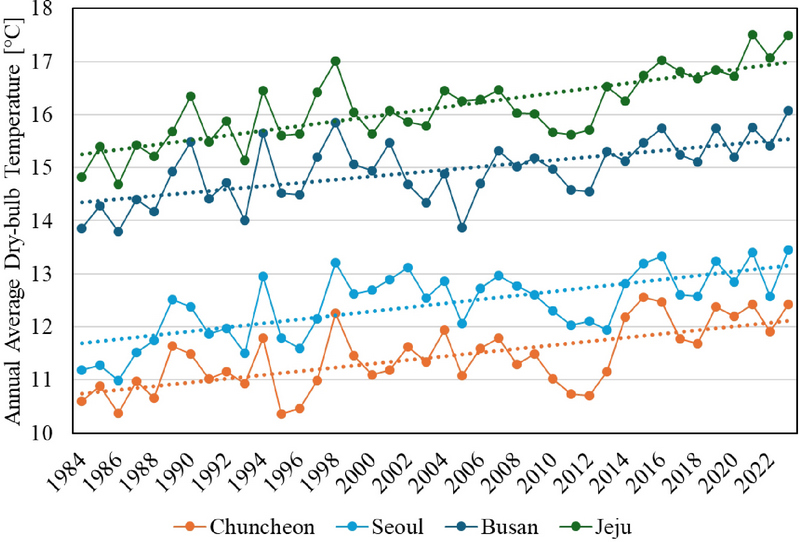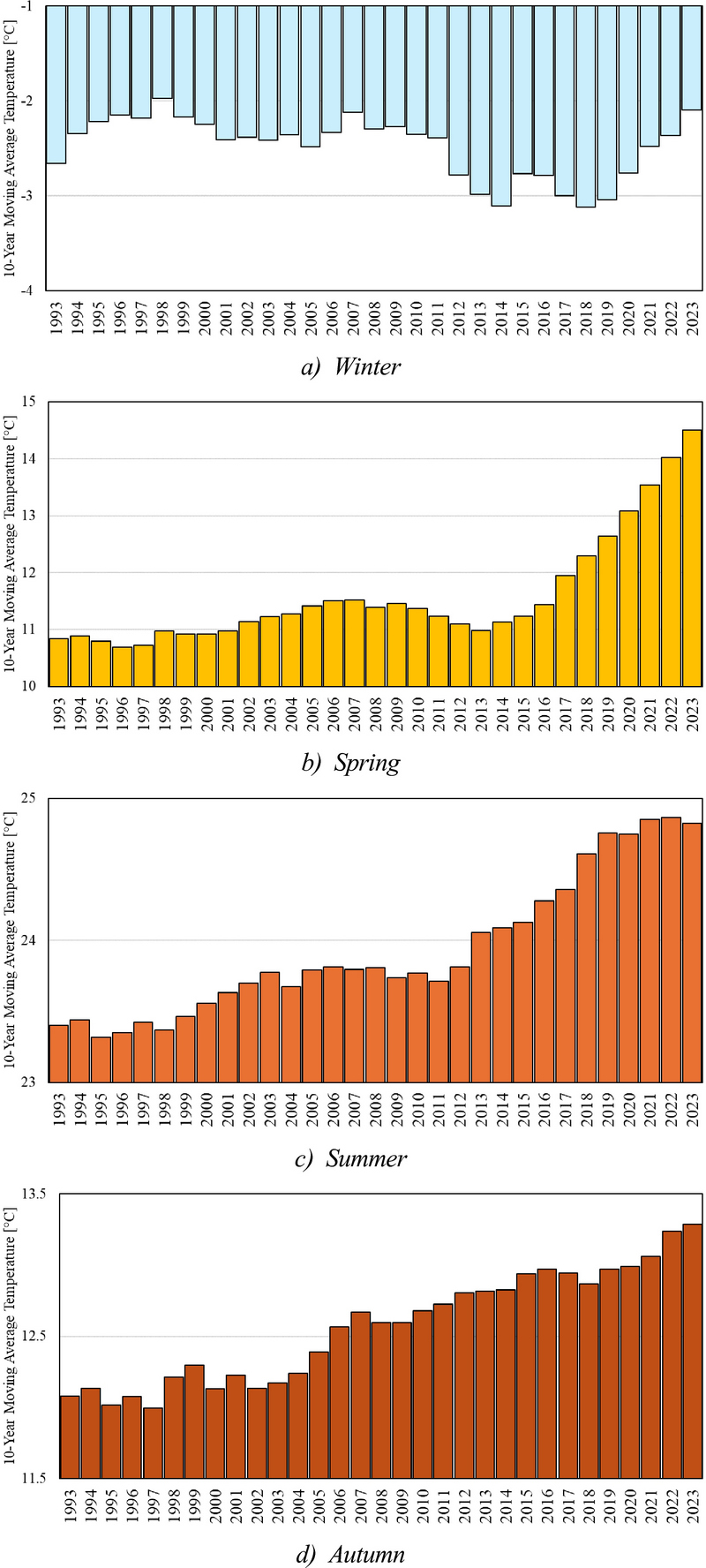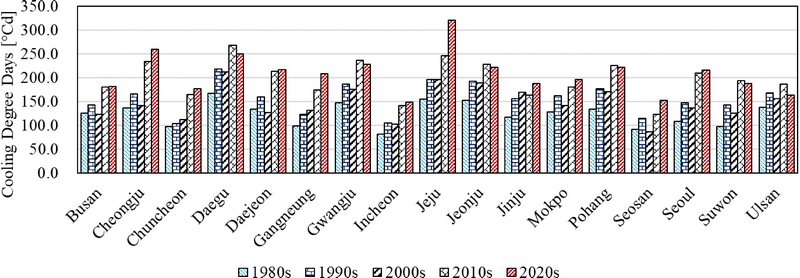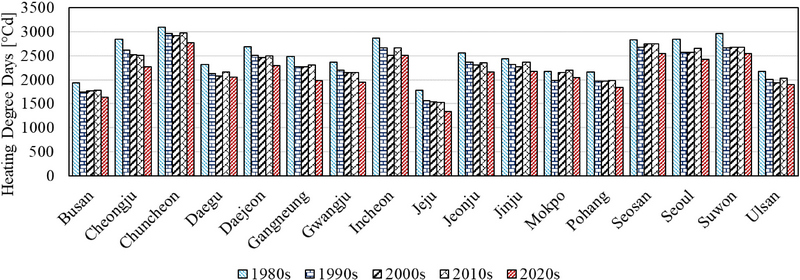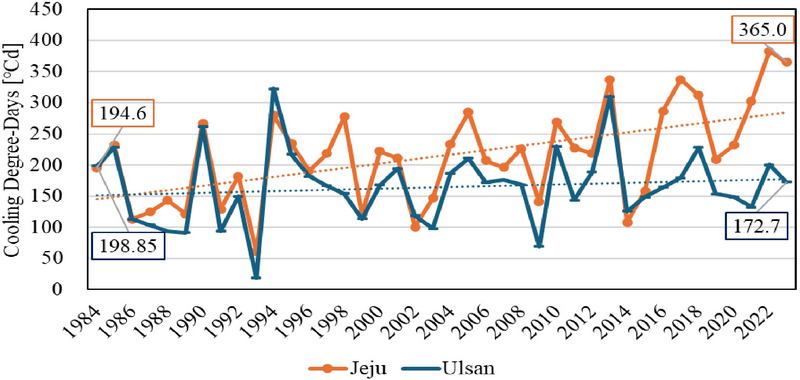
Effects of Outdoor Conditions and Heating and Cooling Degree-Days on Climate Change
ⓒ 2024. KIEAE all rights reserved.
Abstract
This study investigates the effects of the outdoor conditions and heating and cooling degree-days on climate change. Accurate climate data is crucial for energy-consumption assessments and energy-saving solutions. To this end, this study examined historical weather data to investigate the changes in dry-bulb temperature and the trends in heating and cooling degree-days.
Dry-bulb temperature data for 17 cities in South Korea were collected from the weather data service of Korea Meteorological Administration. Data spanning from January 1, 1984 to December 31, 2023 were evaluated, and the missing data were interpolated using linear methods. Heating and cooling degree-days were then calculated using the degree-days method by applying a consistent base-temperature across decades and cities.
The results indicated a rise in the average annual dry-bulb temperatures across all cities, particularly during 2010s and 2020s. Analysis of the moving average temperatures by season showed that, except for a few years, the moving average temperatures for spring, summer, and autumn have consistently increased. The cooling degree-days increased significantly, particularly in Jeju, while the heating degree-days decreased significantly, such as in Cheongju. These trends suggest that relying on outdated climate data could lead to miscalculations in building energy consumption, which necessitates the use of recent data for accurate energy analysis and capacity planning.
Keywords:
Climate Change, Outdoor Condition, Heating and Cooling Degree-Day, Energy Consumption1. Introduction
1.1. Background and Purpose
global warming is a worldwide predicament. The Intergovernmental Panel on Climate Change (IPCC) has recognized the severity of the climate change problem and has warned that net-zero emissions must be achieved by 2050 to limit the average temperature increase to 1.5℃ by 2100 [1]. However, global warming is already underway, and the global primary energy consumption is projected to increase by 32% by 2040 compared to that in 2017 [2]. The increase in air and ocean temperatures, melting of snow and ice, and rise in mean sea level [3] that have already been observed indicate that climate change is already underway [4], and more extreme weather events are expected [5, 6]. Changes in the outdoor temperatures because of climate change will affect water resources, power generation, agriculture, and so on [7]. For instance, the energy consumption in building sector [12-14] will be affected, as energy demand for cooling will increase [8, 9] and that for heating will decrease [10, 11]. Considering that the building sector accounts for more than 30% of the world's final energy consumption [15] and 30% of greenhouse gas emissions [16, 17], it is imperative to provide solutions by designing new buildings in an energy-efficient manner and assessing the energy consumption of the existing buildings to combat climate change. However, considering the gradual changes in the climatic conditions because of global warming caused by human activities, implementing solutions based solely on the current climate data may cause deviations from the expected energy-efficient performance of the building designs [18].
In a previous study, Cho et al. calculated the heating degree-days (HDD) using weather data from 1971 to 2006, and compared them to the HDD established in the 1980s. They found that the HDD decreased by more than 10% compared to the 1980s [19]. Jung calculated the cooling degree-days (CDD) for major cities in South Korea using the daily average outdoor temperature data for the years 1981~2010. Comparing the results of the CDD calculated at a level of 10 years with those calculated at a level of 30 years revealed that the CDD increased gradually from the 1980s to the 2000s in five cities: Chuncheon, Gangneung, Ulsan, Jeju, and Daegu [20]. Rey-Hernandez et al. compared energy consumption in the current and future climates for zero-energy buildings in Spain, which have a high probability of receiving 98 points in the LEED certification as of 2018. Using 2020 as a baseline, they compared the extrapolated energy consumption in 2050 and 2080, and demonstrated that energy-demand patterns will change over time owing to the effects of climate change [21]. Yang et al. examined the impact of climate change in five different climate zones in Europe. They compared the energy demand for heating and cooling between three climate change scenarios: 2010~2039 (near future), 2040~2069 (intermediate future), and 2070~2099 (distant future). The results showed that while energy demand varied across climate zones, the cooling energy demand generally increased unlike the heating energy demand [11]. In another study, Xiong et al. estimated that the cooling energy demand in urban residential buildings in China will increase by 14% to 20% between 2023 and 2060 [22]. Invidiata and Ghisi examined the energy consumption of residential buildings in three Brazilian cities. They found that all the cities will be affected by a warm climate, resulting in a steady increase in the energy demand over the next 60 years [23].
Numerous studies have proved that the heating energy consumption will decrease over time, while the cooling energy consumption will increase. As temperatures rise owing to the effects of climate change, differences between past and present weather conditions occur. Disregarding these differences can impact the given conditions, which may differ from the actual conditions, in building energy-use analyses and capacity calculations. Furthermore, it is essential to understand the effects of climate change on the rising temperatures when developing detailed energy conservation plans to reduce energy consumption in the building sector [24].
In this context, this study aims to examine the changing trends of outdoor conditions that may affect the energy-consumption assessment, heating and cooling equipment capacity estimation, and energy-conservation planning using historical weather data for 40 years, that is, from 1984 to 2023. Based on this weather data, the changes in the outdoor dry-bulb temperatures were quantitatively analyzed by region. In addition, the changing trend in the heating and cooling degree-days were also analyzed by year and region using the same base temperature through the degree-day method [24], which is a simple method for estimating the heating and cooling energy requirements of buildings.
2. Methodology
2.1. Data Collection and Interpolation
To estimate the outdoor weather conditions, and heating and cooling degree-days according to the climate changes, meteorological data was collected. Specifically, we collected the dry-bulb temperature data of 17 regions listed in Appendix 7 of the Energy Saving Design Standards from the Korea Meteorological Administration’s Open Weather Data Portal [26]. The 17 regions are as follows: 1 from the Central Region I, 8 from the Central Region II, 7 from the Southern Region, and Jeju Province. The weather data from Automated Synoptic Observing System (ASOS) were collected. For the cities without ASOS data, Automatic Weather System (AWS) data were used as substitutes. For the weather data, the dry-bulb temperature data for the 40-year period from January 1, 1984 to December 31, 2023 were used. The collected weather data had inconsistently missing values in random during the 1980s (that is, 1984~1989). The inconsistent missing values accounted for 3.02% to 13.09% of the data depending on the region, and the missing values were interpolated using a liner interpolation method. This is a method of estimating missing data by connecting known points with straight lines. For example, suppose the dry-bulb temperature at hour n is missing, and the temperature data at hours n-1 and n+1 are available. Then, the missing value can be estimated as shown in Eq. (1).
| (Eq. 1) |
where, Tn is the outdoor temperature (℃) at hour n.
To evaluate the accuracy of the linear interpolation, 10% of the non-missing original data were randomly removed and the error was then calculated using the Root Mean Square Error (RMSE) and Mean Absolute Error (MAE). Based on the calculated errors. The data was interpolated using quadratic linear interpolation and it was determined that the RMSE and MAE of the dry-bulb temperature ranged from 0.125℃ to 0.186℃ and from 0.027℃ to 0.039℃, respectively.
2.2. Degree-Day Method
In the 1930s, the heating-energy use in buildings were estimated using the degree-day method, which was developed to estimate the energy consumption by calculating how often and how much the average daily temperature (that is, the average of the daily maximum and minimum temperatures) in a given area was above or below a base temperature [25]. The sum of the number of heating- or cooling-days per year in a region represents the climatic severity of that region. When calculating the degree-days, a base temperature was used to indicate that cooling and heating, respectively, was required above and below the base temperature. The cooling and heating degree-days were calculated by summing the difference between the average daily temperature and base temperature, as shown in Eqs. (2) and (3).
| (Eq. 2) |
| (Eq. 3) |
where, HDD is the heating degree-days (HDDn), CDD is the cooling degree-days (CDDn), Tbase is the base temperature (℃), and Teqaligni is the average daily temperature (℃). The superscript + symbol indicates that the value in the parentheses is included in the sum only if it is positive [27]. When calculating the heating and cooling degree-days, it is important to use an appropriate base temperature because the calculation results vary depending on the value of Tbase. In this regard, the American Society of Heating, Refrigerating, and Air-Conditioning Engineers (ASHRAE) recommends using 18.3℃ as the base temperature when calculating the heating and cooling degree-days in countries where there are no standards. However, in this study, the heating and cooling degree-days were calculated using the base temperatures (18℃ for HDD and 24℃ for CDD) used to calculate the heating and cooling degree-days in the Monthly Heating and Cooling Degree Days Statistics from the Data Portal [28]. Therefore, the heating and cooling degree-days were denoted as HDD18 and CDD24, respectively.
3. Outdoor Condition Changes
The outdoor temperature is a very important factor on which the heating and cooling operations are based on. Heating is performed in winter when the outdoor temperature is low, while cooling is performed in summer when the temperature is high. Because the system design and energy consumption assessment are performed based on the outdoor temperature, it has a significant impact on the building energy consumption, and any changes in the same should be sensitively reflected.
3.1. Dry-bulb Temperature Changes
The 17 regions, which is the scope of this study, were categorized into Central Region I, Central Region II, Southern Region, and Jeju Island. Fig. 1. shows the trend of the average annual dry-bulb temperature data from 1984 to 2023 in four cities that represent the categorized regions, respectively.
Chuncheon had the highest average annual temperature of 16.1℃ in 2023 and a lowest temperature of 13.8℃ in 1986. In Seoul, the highest was 13.5℃ in 2023 and the lowest was 11.0℃ in 1986. In Busan, the highest and lowest were 16.1℃ in 2023 and 13.8℃ in 1986, respectively. In Jeju, the highest was 17.5℃ in 2021 and the lowest was 14.7℃ in 1986. In these cities, the dry-bulb temperature exhibited an increasing trend, although it fluctuated from year to year. Examining the years with the highest and lowest temperatures in each region, established that Chuncheon in Central Region I had an average annual temperature of 10.6℃ in 1984 and 12.41℃ in 2023, showing an increase of 1.8℃. The temperatures also increased by 2.3℃ (from 11.2℃ to 13.5℃) in Central Region II (Seoul), by 2.2℃ (from 13.9℃ to 16.1℃) in the Southern Region (Busan), and by 2.7℃ (from 14.8℃ to 17.5℃) in Jeju.
The long-term changing trend of the dry-bulb temperature was also investigated by year using moving averages. It is a statistical technique used to smoothen short-term fluctuations and identify long-term trends or changes. In this study, moving averages were used to analyze the trend of the changes in the dry-bulb temperatures by season at a level of 10 years. After listing the dry-bulb temperatures for winter (January, February, and December), spring (March, April, and May), summer (June, July, and August), and fall (September, October, and November), the moving average for each decade was estimated using Eq. (4).
| (Eq. 4) |
where, Ts,y is the average temperature (℃) of season s in year y, and MA10(Ts,y) is the 10-year moving average temperature (℃) of Ts,y.
Fig. 2. shows the 10-year moving averages by season in Chuncheon. Fig. 2. (a) shows that of winter, in which the moving average temperature fluctuated, that is, the increase/decrease was repeated until 2018 (average temperature for 2009~2018); however, it increased from -3.1℃ to -2.1℃ from 2018 to 2023 (average temperature for 2012~2023). Fig. 2. (b-d), in which the moving average temperatures are shown for spring, summer, and fall, respectively, show a continuously increasing trend except for the years 2013, 2011, and 2009, respectively. Particularly, in the spring season, the temperature increased significantly from 11.0℃ in 2013 to 14.5℃ in 2023. When the analysis was performed by applying the same moving averages to the three representative regions besides Chuncheon, the results were similar, although the magnitude of increase or decrease varied. In particular, the winter moving averages showed a decreasing trend from 2009 to 2013 in all the regions, unlike the other seasons, and an increasing trend from 2017 or 2018 to 2023.
4. Analysis of the Heating and Cooling Degree-Days
Heating and cooling degree-days are a simple way to estimate the energy consumption by summing based on a base temperature and an average outdoor temperature. Therefore, by applying the same base temperature, the mechanism of change in the energy demand with respect to the outdoor temperature changes under the same conditions can be investigated. Fig. 3. and Fig. 4. show the trends of the CDD and HDD, respectively, by period for each region. The change in the cooling and heating degree-days from 1984 to 2023 was examined by dividing it into the 1980s (1984~1989), 1990s (1990~1999), 2000s (2000~2009), 2010s (2010~2019), and 2020s (2020~2023).
In Fig. 3., which shows the distribution of the average CDD by period for each region, the following can be observed for Busan: 125.9 CDD24 in the 1980s, 142.5 CDD24 in the 1990s, 122.6 CDD24 in the 2000s, 180.8 CDD24 in the 2010s, and 181.4 CDD24 in the 2020s. Compared to the 1980s, there was an increase of 16.7 CDD24 in the 1990s; however, this was followed by the lowest value of 122.6 CDD24 in the 2000s. An increase of 52.2 CDD24 was then observed in the 2010s. The 2010s and 2020s had similar values, with a difference of 0.6 CDD24. The average CDD by period were generally the highest in the 2010s or 2020s, which indicates that CDD was increasing compared to the past. Moreover, comparing the CDDs from the 1980s to the 2020s, it was established that Daegu, Gwangju, Jeonju, Pohang, Suwon, and Ulsan had the highest CDD in the 2010s, while the other regions exhibited the highest CDD in the 2020s. The highest change in CDD was in Jeju, where it increased continuously from 154.9 CDD24 in the 1980s to 320.5 CDD24 in the 2020s, more than doubling. Ulsan, however, had the smallest change in CDD, with 138.2 CDD24, 167.9 CDD24, 156.2 CDD24, 187.2 CDD24, and 163.5 CDD24 from the 1980s to the 2020s, respectively, showing a fluctuating trend.
In Fig. 4., which shows the distribution of HDD, the following can be observed for Busan: 1,939.9 HDD18 in the 1980s, 1,737.9 HDD18 in the 1990s, 1,765.1 HDD18 in the 2000s, 1,783.4 HDD18 in the 2010s, and 1,641.3 HDD18 in the 2020s, which exhibited a decrease of 202 HDD18 in the 1990s compared to the 1980s. From the 1990s to the 2010s, the HDD18 increased by 27.2 and 18.3 HDD18, respectively, based on the 2000s, however, the 2020s showed the lowest value. Other regions also exhibited a fluctuating pattern (that is, increasing and decreasing back and forth) from the 1990s to the 2010s, except Mokpo, which showed the lowest HDD value in the 2020s. The highest change in HDD was in Jeju, where it decreased continuously from the 1980s to the 2020s. The average HDD decreased from 1,777.5 HDD18 in the 1980s to 1,341.1 HDD18 in the 2020s, with a decrease of 24.5%. Cheongju also exhibited a continuous decrease in HDD, from 2,844.7 HDD18 in the 1980s to 2,273.7 HDD18 in the 2020s, with a decrease of 20.1%. On the other hand, in Mokpo, the HDD decreased by 189.4 HDD18, from 2,173.8 HDD18 in the 1980s to 1,984.4 HDD18 in the 1990s, however, it increased to 2,149.1 HDD18 in the 2000s, 2,197.6 HDD18 in the 2010s, and 2,043.9 HDD18 in the 2020s. That is, the lowest HDD was observed in the 1990s.
Fig. 5. shows the sum of the CDDs for each year for Jeju and Ulsan, where the change in CDD was the largest and smallest, respectively.
In Jeju, the fluctuations were repeated between 1984 and 2023, however, there was an increase from 194.6 CDD24 in 1984 to 365.0 CDD24 in 2023. Notably, the highest CDD was observed in 2022 with a 383.2 CDD24. In Jeju, the average CDD for the entire period was 215.1 CDD24, with a difference of 149.9 CDD24 from 2023, exhibiting a significant increase in the CDD. Ulsan, like Jeju, experienced fluctuations from 1984 to 2023, however, it showed a decrease from 198.85 CDD24 in 1984 to 172.7 CDD24 in 2022. The highest CDD in Ulsan was observed in 1994 with a 322.5 CDD24, and the average CDD for the entire period was 164.9 CDD24, with a difference of 7.7 CDD24 from 2023. This shows that the CDD is constantly fluctuating.
Fig. 6. shows the trend of the annual HDD in Cheongju, where the HDD decreased continuously from the 1980s to the 2020s, and in Mokpo, where the HDD was the highest in the 1990s. Fig. 6. also shows that the increase and decrease of the HDD was repeated in Cheongju from year to year, with a decrease of 906.3 HDD18, from 3,061.8 HDD18 in 1984 to 2,155.6 HDD18 in 2023. The average HDD in Cheongju over the entire period was 2,566.5 HDD18, which shows a difference of 410.9 HDD18 from 2023. In Mokpo, the HDD decreased from 2,329.9 HDD18 in 1984 to 1,974.9 HDD18 in 2023, however, the trend line generated based on the fluctuations is in an upward direction, showing an increasing HDD trend. The average HDD in Mokpo during the whole period was 2,113.2 HDD18, which shows a difference of 138.3 HDD18 from 2023.
To compare the increase and decrease of heating and cooling degree-days by region, Table 1. lists the slope of the trendline of the heating and cooling degree-days from 1984 to 2023. The slope of the trendline indicates the rate of change in the degree-days over the entire period (1984~2023). A negative slope of the trendline for the HDD indicates a decreasing trend in the degree-days over the entire period, and a smaller slope indicates a greater decrease in HDD. Conversely, a positive slope indicates an increasing trend in HDD. In the case of CDD, unlike HDD, a greater slope of the trendline indicates a greater increase in the CDD over the entire period.
In Table 1., the slope of the HDD trendline from 1984 to 2023 in Busan is -5.4, which indicates a decreasing trend. During the same period, the slope of the CDD trendline is 1.4, which indicates an increasing trend.
The largest decrease in the HDD was in Jeju, with a trendline slope of -9.2. On the other hand, HDD increased in Mokpo, where the trendline slope was 0.96. It was also observed that the HDD decreased continuously in all the regions except for Mokpo. For CDD, Jeju had a trendline slope of 3.58, which was the highest, and even Ulsan, which had the lowest slope, showed an increasing trend with a slope of 0.67.
While the increasing/decreasing trend of the heating and cooling degree days varied from region to region, the HDD showed a decreasing trend and the CDD exhibited an increasing trend.
5. Conclusion
In this study, the changes in the dry-bulb temperature, and the heating and cooling degree-days were analyzed using 40 years of historical meteorological data, from 1984 to 2023, to investigate the changes in weather conditions caused by the climate change.
In this analysis, the dry-bulb temperature changes in four representative cities were depicted based on the categorized regions (Central Region I, Central Region II, Southern Region, and Jeju). As a result of listing the annual average outdoor dry-bulb temperatures from 1983 to 2023, it was established that the overall trend increased, while the fluctuations (increase/decrease) was repeated in each year from the past to the present. Furthermore, the seasonal temperature trend was analyzed using the 10-year moving averages, and it was determined that the moving average temperature continuously increased in spring, summer, and fall except for some years. In winter, the average temperature decreased from 2009 to 2013 in all the regions, and the average temperature exhibited an increasing trend from 2017 or 2018 to 2023.
In the analysis of the cooling and heating degree-days, the magnitude of the increase and decrease varied from region to region, however, overall, the CDD showed an increasing trend, and the HDD showed a decreasing trend. Comparing the 1980s and 2020s, it was observed that the CDD increased in all the regions, particularly in Jeju, where the CDD more than doubled in 2023 compared to 1984 on a year-on-year basis. In contrast to the CDD, the HDD decreased in all the regions. In Cheongju, the HDD decreased from 3,061.8 HDD18 in 1984 to 2,155.6 HDD18 in 2023. This is similar to the results of previous studies on heating and cooling degree-days [19, 20], thereby indicating the need for further research on the heating and cooling energy demand and energy consumption because of the climate change impact.
In the scope of this study, the base temperature for calculating the heating and cooling degree days was 18℃ for HDD (HDD18) and 24℃ for CDD (CDD24), rather than 18.3℃ as recommended by the ASHRAE. This resulted in a slightly larger HDD and a slightly smaller CDD than the results calculated using the base temperature recommended by the ASHRAE. The changes in the dry-bulb temperature and degree-days were also analyzed based on the weather data from the past to the present, and the outdoor conditions will continue to change owing to the effects of climate change. Because changes in the outdoor conditions causes changes in future energy demands and consumption [11, 21-23], further research is required to analyze the energy consumption and calculate the equipment capacity considering the climate change.
Acknowledgments
This research was supported by the National Research Foundation of Korea, funded by the Government of South Korea (Ministry of Science and ICT) in 2020 (Grant No. 2020R1C1C1010801).
References
-
B. Jones et al., Assessing uncertainty in housing stock infiltration rates and associated heat loss: English and UK case studies, Building and Environment, 92, 2015.10, pp.644-656.
[https://doi.org/10.1016/j.buildenv.2015.05.033]

- EIA (U.S. Energy Information Administration), International energy outlook 2019, 2019.
- IPCC (Intergovernmental Panel on Climate Change), Climate change 2014: Synthesis report summary for policy makers, 2014.
-
I. Andrić et al., The impact of climate change on building heat demand in different climate types, Energy and Buildings, 149, 2017.08, pp.225-234.
[https://doi.org/10.1016/j.enbuild.2017.05.047]

-
S.J. Brown, Future changes in heatwave severity, duration and frequency due to climate change for the most populous cities, Weather and Climate Extremes, 30, 2020.12, 100278.
[https://doi.org/10.1016/j.wace.2020.100278]

-
K. Sun et al., Passive cooling designs to improve heat resilience of homes in underserved and vulnerable communities, Energy and Buildings, 252, 2021.12, 111383.
[https://doi.org/10.1016/j.enbuild.2021.111383]

-
L.M. Al-Hadhrami, Comprehensive review of cooling and heating degree days characteristics over Kingdom of Saudi Arabia, Renewable and Sustainable Energy Reviews, 27, 2013.11, pp.305-314.
[https://doi.org/10.1016/j.rser.2013.04.034]

-
A.V. Farahani et al., Overheating risk and energy demand of Nordic old and new apartment buildings during average and extreme weather conditions under a changing climate, Applied Sciences, 11(9), 2021.04, 3972.
[https://doi.org/10.3390/app11093972]

-
A.M.R. Nishimwe, S. Reiter, Estimation, analysis and mapping of electricity consumption of a regional building stock in a temperate climate in Europe, Energy and Buildings, 253, 2021.12, 111535.
[https://doi.org/10.1016/j.enbuild.2021.111535]

-
M. Santamouris, Cooling the buildings – Past, present and future, Energy and Buildings, 128, 2016.09, pp.617-638.
[https://doi.org/10.1016/j.enbuild.2016.07.034]

-
Y. Yang, K. Javanroodi, V.M. Nik, Climate change and energy performance of european residential building stocks – A comprehensive impact assessment using climate big data from the coordinated regional climate downscaling experiment, Applied Energy, 298, 2021.09, 117246.
[https://doi.org/10.1016/j.apenergy.2021.117246]

-
A. Moazami et al., Impacts of future weather data typology on building energy performance – Investigating long-term patterns of climate change and extreme weather conditions, Applied Energy, 238, 2019.03, pp.696-720.
[https://doi.org/10.1016/j.apenergy.2019.01.085]

-
E. Moreci, G. Ciulla, V.L. Brano, Annual heating energy requirements of office buildings in a European climate, Sustainable Cities and Society, 20, 2016.01, pp.81-95.
[https://doi.org/10.1016/j.scs.2015.10.005]

-
L. Clarke et al., Effects of long-term climate change on global building energy expenditures, Energy Economics, 72, 2018.05, pp.667-677.
[https://doi.org/10.1016/j.eneco.2018.01.003]

- IEA (International Energy Agency), Energy market report 2015, OECD/IEA, 2015.
-
M.S.S. Danish et al., A managed framework for energy-efficient building, Journal of Building Engineering, 21, 2019.01, pp.120-128.
[https://doi.org/10.1016/j.jobe.2018.10.013]

-
M. Aksoezen et al., Building age as an indicator for energy consumption, Energy and Buildings, 87, 2015.01, pp.74-86.
[https://doi.org/10.1016/j.enbuild.2014.10.074]

-
L. Pajek, M. Košir, Strategy for achieving long-term energy efficiency of European single-family buildings through passive climate adaptation, Applied Energy, 297, 2021.09, 117116.
[https://doi.org/10.1016/j.apenergy.2021.117116]

- S.H. Cho, S.S. Kim, C.Y. Choi, Study on the revision of HDD for 15 main cities of Korea, Korea Journal of Air-Conditioning and Refrigeration Engineering, 22(7), 2010.07, pp.436-447.
- J.H. Jung, Examination of cooling degree days for main cities of Korea, Conference Journal of KIEAE, 2011, pp.211-214.
-
J.M. Rey-Hernández et al., Modelling the long-term effect of climate change on a zero energy and carbon dioxide building through energy efficiency and renewables, Energy and Buildings, 174, 2018.09, pp.85-96.
[https://doi.org/10.1016/j.enbuild.2018.06.006]

-
J. Xiong et al., Predicting the response of heating and cooling demands of residential buildings with various thermal performances in China to climate change, Energy, 269, 2023.04, 126789.
[https://doi.org/10.1016/j.energy.2023.126789]

-
A. Invidiata, E. Ghisi, Impact of climate change on heating and cooling energy demand in houses in Brazil, Energy and Buildings, 130, 2016.10, pp.20-32.
[https://doi.org/10.1016/j.enbuild.2016.07.067]

-
A. D’Amico et al., Building energy demand assessment through heating degree days: The importance of a climatic dataset, Applied Energy, 242, 2019.05, pp.1285-1306.
[https://doi.org/10.1016/j.apenergy.2019.03.167]

- ASHRAE (American Society of Heating, Refrigerating and Air-Conditioning Engineers), ASHRAE handbook-Fundamentals 2017, Chapter 19, Energy estimation and modeling methods, 2017.
- Korea Meteorological Administration, Open MET data portal, https://data.kma.go.kr, , 2024.07.01.
- ASHRAE (American Society of Heating, Refrigerating and Air-Conditioning Engineers), ASHRAE handbook-Fundamentals 2017, Chapter 14, Climatic design information, 2017.
- Public Data Portal, Monthly heating and cooling degree days statistics by province Korea Gas Corporation, https://www.data.go.kr/data/15040826/fileData.do, , 2024.07.20.
